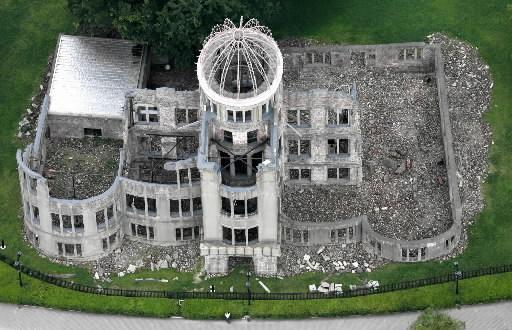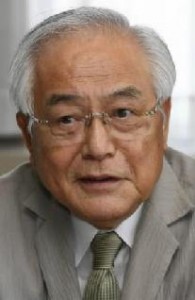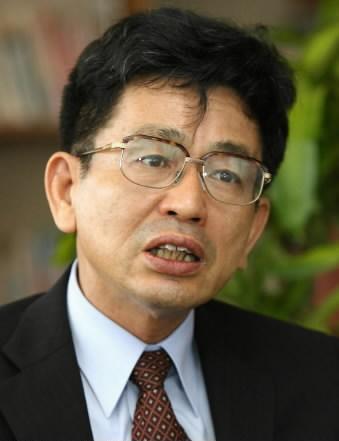The A-bomb Survivors’ Movement: The Past 50 Years, Dialogue 1 [1]
Jul. 7, 2010
Hiroshima’s philosophy of peace
What challenges are posed to us by the A-bombed city of Hiroshima? How widely have the appeals from Hiroshima been conveyed across generations and national borders? This series of articles has been exploring the prospects for peace championed by Hiroshima through the eyes of the 50th anniversary of the A-bomb survivors’ movement. The issue will now be considered from the perspective of four experts with strong links to the city. This article will feature a discussion with two of these experts, Takashi Hiraoka, 78, former mayor of Hiroshima, and Satoru Ubuki, 59, a professor at Hiroshima Jogakuin University.
In the Peace Declaration he issued each August 6 as mayor of Hiroshima, an office he held for two terms and a total of eight years, Mr. Hiraoka stressed Japan’s responsibility in connection with the war in Asia and the Pacific, and advocated abandoning the U.S. nuclear umbrella. Mr. Ubuki is known for his impressive collection of A-bomb related materials and his research involving the A-bomb accounts of the survivors.
The Chugoku Shimbun invited the two, who are engaging in dialogue for the first time, to talk about the evolution of Hiroshima’s philosophy of peace and the outlook for the city’s future.
by Masami Nishimoto, Senior Staff Writer
First, could you please speak to what prompted you to become engaged in A-bomb related issues?
Hiraoka: My family and I moved back to Japan from the Korean Peninsula at the end of September 1945, after Japan’s defeat. I enrolled at Hiroshima High School, still under the prewar education system, located in Minami Ward. People at that time were focused on rising from the rubble of the bombing and the first priority was reconstruction. To construct new school buildings, people from Hiroshima High School went out into the community to raise funds. I saw survivors with keloids every day, but due to my lack of knowledge about radiation, I wasn’t really aware of the horror of the atomic bombing. It was after I became engaged in the student movement during my days in Tokyo that I awakened to the issue. Circumstances emerged during the Korean War (1950-1953) when atomic bombs could have been used. A sense of crisis spread among the public. I myself went to great lengths to collect signatures in support of the Stockholm Appeal (Note 1). The reality, though, was that my efforts were mostly political. After joining the staff of the Chugoku Shimbun as a reporter, I became involved in covering issues related to the atomic bombing around 1960. I learned a lot from Toshihiro Kanai (Note 2). I worked on a series entitled “20 Years After the Bombing” (Note 3) and, in delving anew into the history of the issue, I came to a deeper awareness of the reality of the damage wrought by the atomic bombing.
What was behind your visit to South Korea in the fall of 1965, when the Treaty on Basic Relations between Japan and the Republic of Korea was established, to raise awareness of A-bomb survivors there who had been overlooked?
Hiraoka: In the spring of 1965, a young man hospitalized at a national hospital in Masan, South Korea sent a letter to the Chugoku Shimbun in Japanese. The letter was forwarded to me. The man wrote that he had been exposed to the atomic bombing near Hijiyama Hill in Minami Ward and he hoped to receive medical treatment in Japan. At the time, those campaigning against atomic and hydrogen bombs were blind to the plight of other victims who suffered the blast as a consequence of Japan’s colonial rule. The A-bomb survivors in South Korea couldn’t see Japan as a peaceful nation, while the Japanese seemed to disregard the days when our nation was an aggressor. The people involved in the campaign, who considered the South Korean government a military regime, had great difficulty sympathizing with the issue of A-bomb survivors living in South Korea.
Ubuki: I entered university in 1965. At that time, from morning to night, there were rallies held to oppose the treaty between Japan and South Korea. Because I’m from Hiroshima, other students insisted that I take the lead in organizing activities connected to the atomic bombing. So we took part in the Peace Memorial Ceremony and the World Conference against A & H Bombs. There were various events that took place around the venues, like singing folk songs, and I found them captivating. Peace activists from throughout the nation were gathered here in Hiroshima so I felt that the visit home helped me understand the reality of the issue. Views of the campaign against atomic and hydrogen bombs have changed from generation to generation. The generation before mine was consumed with the split in the campaign. The newspapers covered that split intently. For me, though, the split is simply a fact and a starting point.
I was working for Hiroshima Prefecture and involved in compiling “The History of Hiroshima Prefecture.” To conduct research for the 1973 edition of “The A-bomb Documents,” I spent a night in Tokyo with Professor Seiji Imahori (Note 4). Professor Imahori told me at the time: “I feel frustrated with the campaign.” I replied: “I envy your generation, because your involvement in the campaign is so keen, even if it brings frustration.” Professor Imahori responded that we should just go to sleep. I assume he thought it unproductive to engage with me in conversation about the campaign. Still, people like me, part of the generation of the 1970 Japan-U.S. security alliance, can somehow grasp the passion those like Mr. Hiraoka and Professor Imahori had for the campaign. But the generations afterward are completely apathetic about it.
In 1964, when the campaign against atomic and hydrogen bombs split into two different factions, Toshihiro Kanai proposed publishing a “white paper for A-bomb and H-bomb sufferers” and announcing it through the United Nations. What were the reasons behind this stronger action to convey the reality of the atomic bombings both in Japan and overseas?
Hiraoka: The campaign against atomic and hydrogen bombs ended up splitting into different factions due to narrow political interests after A-bomb survivors were pushed aside and it became a campaign of political partisans. The people of Hiroshima felt that the split would not have come to pass if only those involved in the campaign had correctly understood the suffering of the A-bomb survivors. Our idea was to revive the effort by returning to its starting point. Mr. Kanai began by gathering materials in the belief that an effective appeal to the world could not be made unless the reality of the atomic bombing is truly understood.
Ubuki: Researchers at universities came to the awareness that the consequences of the atomic bombing could be a subject of research, which led to the effort to publish a white paper about the A-bomb sufferers. A few years later, Professor Kiyoshi Shimizu of the Research Institute for Nuclear Medicine and Biology at Hiroshima University, and his colleagues, conducted the Hypocenter Reconstruction Study (Note 5), which took an approach that differed from the campaign against atomic and hydrogen bombs. Researchers, citizens, and people in the media began to be engaged in the issue of the A-bomb damage. The 20th anniversary of the atomic bombing served as a turning point for the direction of the city’s conceptualization of the A-bomb experience.
The concept of A-bomb coverage emerged. The obsession with which the media took up the issue was triggered by the Chugoku Shimbun’s coverage of the 20th anniversary of the bombing. After this, the trend was continuous. Then, in the latter half of the 1960s, a variety of organizations concerned with the issue were established and they came to be very active.
Another important factor has been the emergence of peace education, which developed side by side with the effort to compile the white paper. Hiroshima Prefecture designated August 6 as a school day in the midst of summer vacation and the City of Hiroshima followed suit. Local administrations also began to be involved in peace education activities. In order for the people of Hiroshima to feel engaged in the efforts to support the A-bomb survivors, they need to understand the issues. It was this kind of action that served to create an environment which led to the implementation of the Law Concerning Special Measures for Atomic Bomb Survivors in 1968.
In the 1970s, voices were often raised saying that the A-bomb experience was being forgotten. What do you think was the turning point for the appeals that became based on experiences of the atomic bombing?
Hiraoka: That had to do with the issue involving Japanese aggression. Emphasizing the idea of being victims was no longer viable. With the Japanese government, starting to describe Japan as “the only A-bombed nation,” South Korea and China responded that “Not all victims are necessarily Japanese.”
What was the reaction of A-bomb survivors’ organizations in Japan regarding the court case of Son Jin Doo (Note 6), which you were supporting as a private citizen?
Hiraoka: They turned a cold shoulder. Mr. Son had smuggled himself into Japan at Karatsu City in Saga Prefecture to seek medical treatment. He asked that the Atomic Bomb Survivor’s Certificate be issued to him in Fukuoka Prefecture. These are among the reasons why the organizations in Hiroshima reacted coldly. In addition, they insisted that they couldn’t support someone who had broken the law, saying that such a person couldn’t become a symbol of their campaign. I argued with them, appealing to reason. I said that the atomic bomb exploded over everyone--the old and the young, male and female, the good and the bad--all were alike in suffering the atomic bombing. Therefore, even those who broke the law should be supported. A-bomb survivors living in South Korea are human beings, too. But those involved in the campaign against atomic and hydrogen bombs didn’t pay much attention to the lawsuit. At the time, they didn’t attach importance to the idea of filing lawsuits.The “court case of Shimoda” (Note 7) was filed with the Tokyo District Court. Although the plaintiffs for the case are A-bomb survivors in Hiroshima, the case received little support and ended up being focused entirely on legal battles.
Ubuki: When we summarize trends involving the issue, I believe we should look to one factor: What measures has the Japanese government itself undertaken? One decisive turning point emerged in the latter half of the 1960s when the government began showing support for the three non-nuclear principles.
Then, since the 1970s, Japanese prime ministers started to feel that they should attend the annual Peace Memorial Ceremony in Hiroshima and their observance of the occasion became a norm. This development demonstrates that attendance at the ceremony was viewed as a policy of the government.
The issue of Japanese aggression arises because the conceptualization of the atomic bombing of Hiroshima and internationalization of Japan have not matured. For example, Prime Minister Yasuhiro Nakasone, attended the ceremony in 1987 and described Japan as an “unsinkable aircraft carrier,” marring the ceremony with a militaristic image.
I feel that the Japanese effort to convey the message that “Japan as a nation is against nuclear weapons” is ineffectual. The positions taken by the Japanese government, the City of Hiroshima, and private citizens all differ and so the message with regard to Hiroshima isn’t strong enough, clear enough to register with everyone. The lawsuits mentioned previously conveyed certain messages, but from the judiciary, not the Japanese government. In lieu of the government, the court cases prompted awareness of the existence of A-bomb survivors and the relief measures that are available to them.
Hiraoka: Prior to the statement I delivered at the International Court of Justice (Note 8), I told the Ministry of Foreign Affairs that the City of Hiroshima would declare that “atomic bombs are a violation of international law,” an assertion that the Japanese government itself had difficulty making. Before my statement, a deputy minister from the Foreign Ministry visited Peace Memorial Museum and admitted that such weapons are inhumane. But the stance taken by the Japanese government makes it unable to state that nuclear weapons are a violation of international law.
No one can deny the truth of what happened in Hiroshima and Auschwitz. These experiences evoke images of the total annihilation of human beings. But in the context of international politics and the Japan-U.S. security treaty, the inhumanity of nuclear weapons is ignored.
Takashi Hiraoka
Takashi Hiraoka was born in the city of Osaka. After graduating from Waseda University, he became a reporter for the Chugoku Shimbun in 1952. Mr. Hiraoka was put in charge of a number of feature series, including coverage concerning the 20th anniversary of the atomic bombing. After acting as editor-in-chief of the Chugoku Shimbun and president of RCC Broadcasting Co., Ltd., Mr. Hiraoka served as mayor of Hiroshima for eight years. At present, Mr. Hiraoka is engaged in a variety of citizens’ efforts, and has assumed the role of chairman for C-haus, an organization which promotes networking within the Chugoku Region. His publications include “Henken to Sabetsu” (“Prejudice and Discrimination”) and “Kibo no Hiroshima” (“Hope in Hiroshima”). Mr. Hiraoka lives in Nishi Ward.
Satoru Ubuki
Satoru Ubuki was born in the city of Kure in Hiroshima Prefecture. After graduating from Kyoto University, he supervised the compiling of such papers as “The A-bomb Documents” for Hiroshima Prefecture starting in 1970. After working as an assistant professor at the Research Institute for Nuclear Medicine and Biology at Hiroshima University (today, the Research Institute for Radiation Biology and Medicine), Mr. Ubuki has served as a professor at Hiroshima Jogakuin University since 2001. Mr. Ubuki’s publications include “Heiwa Shikiten no Ayumi” (“The Development of the Peace Memorial Ceremony”) and “Genbaku Shuki Keisai Tosho Zasshi Somokuroku” (“General Catalog of Books and Magazines Carrying A-Bomb Survivors’ Essays”). His specialty is the history of postwar Japan and the history of the atomic bombing. Mr. Ubuki lives in Kure.
(Note 1) Stockholm Appeal: In 1950, the standing committee of the World Congress of Partisans of Peace, held in Sweden, appealed for a total ban on atomic bombs. Roughly 500 million people in the world are said to have attached their signatures to the appeal.
(Note 2) Toshihiro Kanai: Mr. Kanai was a former chief editorial writer for the Chugoku Shimbun. He stood at the forefront of Hiroshima’s opposition to nuclear weapons. His efforts included proposing the publication of a white paper on A-bomb and H-bomb sufferers in 1964, arguing “Have the atomic bombs come to be known for their power? Or have the atomic bombs come to be known for their human tragedy?” Mr. Kanai died in 1974.
(Note 3) “20 Years After the Bombing”: A series of feature articles comprised of “Convey These Voices to the World,” “Journey from the Fire,” and “Record of Hiroshima.” The series appeared in 30 installments starting on July 8, 1965 and won the Japan Newspaper Publishers & Editors Association Award (the Nihon Shinbun Kyokai Award) in 1965.
(Note 4) Seiji Imahori: Mr. Imahori was a former president of Hiroshima Prefectural Women’s University and a professor of Chinese History at Hiroshima University. He lent his support, from a theoretical perspective, to the campaign against atomic and hydrogen bombs, including the World Conference against A & H Bombs, which was launched in 1955. He was also involved in compiling “Hiroshima and Nagasaki,” a joint initiative conducted by the Cities of Hiroshima and Nagasaki. He died in 1992.
(Note 5) Hypocenter Reconstruction Study: In 1969, the Research Institute for Nuclear Medicine and Biology at Hiroshima University and the Hiroshima branch of NHK jointly reproduced a map of the Nakajima District, which lay within a radius of 500 meters from the hypocenter and is now the location of Peace Memorial Park. In 1977, the Atomic Bomb Damage Reconstruction Study Committee, chaired by Kiyoshi Shimizu and commissioned by the City of Hiroshima, recreated a map of the area of two kilometers from the hypocenter.
(Note 6) The court case of Son Jin Doo: Son Jin Doo, who suffered the atomic bombing in Hiroshima and smuggled himself to Japan in 1970, was seeking the Atomic Bomb Survivor’s Certificate. The Supreme Court found in 1978 that “As national reparations are considered the basis of the system, such reparations also apply to this case.” The finding paved the way for the issuance of the certificate for A-bomb survivors living overseas.
(Note 7) The court case of Shimoda: Ryuichi Shimoda of Hiroshima and four other A-bomb survivors filed the lawsuit in 1955. In 1963, the Tokyo District Court dismissed their right to claim national compensation. The court, however, ruled on the illegality of nuclear weapons, stating that “The dropping of atomic bombs is an indiscriminate attack and a violation of international law.” Mr. Shimoda died in 1964.
(Note 8) Statement at the International Court of Justice: As mayor of Hiroshima, Takashi Hiraoka delivered a statement at a hearing regarding the threat or use of nuclear weapons held by the International Court of Justice in The Hague, the Netherlands in 1995. Mr. Hiraoka said that “The use of nuclear weapons is a violation of international law.” But the Japanese government would not clearly state the same conviction, saying only: “The use of nuclear weapons does not follow the spirit of humanitarianism.” The International Court of Justice issued its advisory opinion in 1996, which states that “the threat or use of nuclear weapons would generally be contrary to the rules of international law.”
(Originally published on July 14, 2006)










